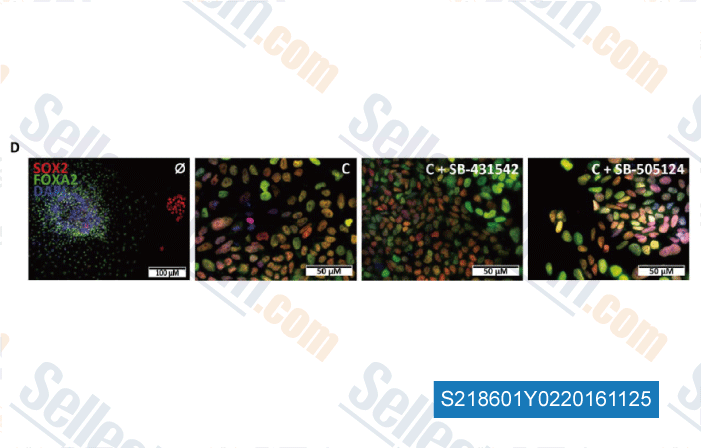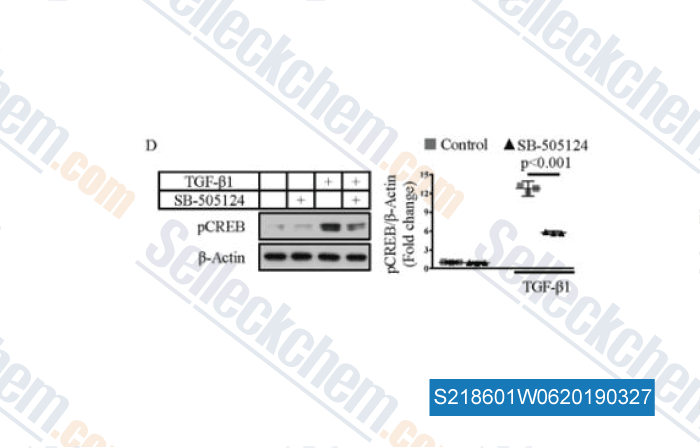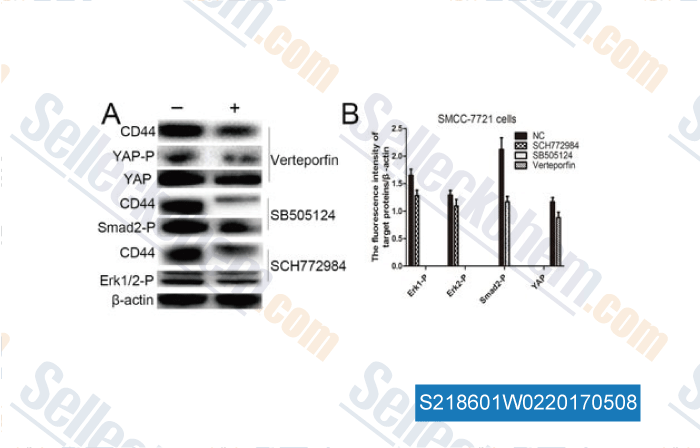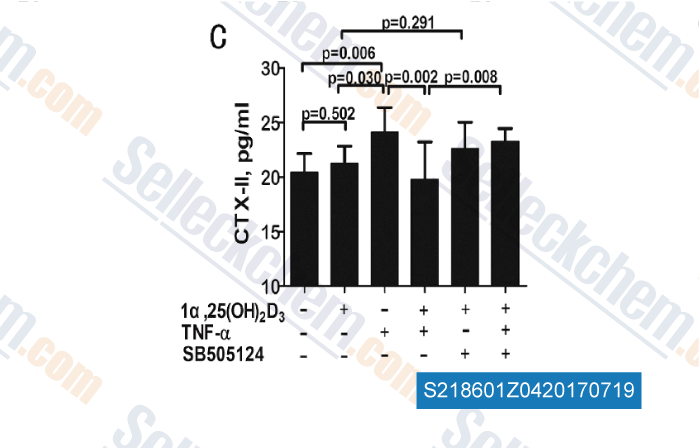|
Toll Free: (877) 796-6397 -- USA and Canada only -- |
Fax: +1-832-582-8590 Orders: +1-832-582-8158 |
Tech Support: +1-832-582-8158 Ext:3 Please provide your Order Number in the email. |
Technical Data
| Formula | C20H21N3O2 |
|||
| Molecular Weight | 335.4 | CAS No. | 694433-59-5 | |
| Solubility (25°C)* | In vitro | DMSO | 67 mg/mL (199.76 mM) | |
| Ethanol | 67 mg/mL (199.76 mM) | |||
| Water | Insoluble | |||
|
* <1 mg/ml means slightly soluble or insoluble. * Please note that Selleck tests the solubility of all compounds in-house, and the actual solubility may differ slightly from published values. This is normal and is due to slight batch-to-batch variations. * Room temperature shipping (Stability testing shows this product can be shipped without any cooling measures.) |
||||
Preparing Stock Solutions
Biological Activity
| Description | SB505124 is a selective inhibitor of TGFβR for ALK4, ALK5 with IC50 of 129 nM and 47 nM in cell-free assays, respectively, also inhibits ALK7, but does not inhibit ALK1, 2, 3, or 6. | ||||
|---|---|---|---|---|---|
| Targets |
|
||||
| In vitro | SB505124 is identified as a reversible ATP competitive and selective ALK inhibitor of ALK4 and ALK5. SB505124 shows no toxicity to renal epithelial A498 cells at concentrations up to 100 μM for 48 hours, and blocks TGF-β–induced apoptosis of FaO cells and NRP 154 cells in a concentration-dependent manner. [1] In human umbilical vein endothelial cells (HUVEC), SB505124 (500 nM) blocks the changes of TGF-β1 on F-actin assembly and prevents ROS production induced by TGF-β. [2] By inhibiting TGF-beta1 signaling, SB505124 leads to decreased (DFO)-induced neurogenesis. [3] A recent study shows that SB505124 suppresses the migration and invasion of breast cancer MCF-7-M5 cells. [4] |
||||
| In vivo | In a rabbit GFS model, SB505124 decreased the intraocular pressure (IOP) levels and reduces subconjunctival cell infiltration and scarring at the surgical site in the GFS. [5] In (TAC)-treated mice and FK12EC KO mice, SB505124 prevents the activation of endothelial TGF-β receptors and induction of renal arteriolar hyalinosis. [6] |
Protocol (from reference)
| Kinase Assay: |
|
|---|---|
| Cell Assay: |
|
| Animal Study: |
|
References
Customer Product Validation

-
Data from [Data independently produced by , , Stem Cells, 2016, 34:2635-2647.]

-
Data from [Data independently produced by , , Osteoarthritis Cartilage, 2017, 25(11):1868-1879]

-
Data from [Data independently produced by , , Oncotarget, 2016, 7(47):77495-77507]

-
Data from [Data independently produced by , , Osteoarthritis Cartilage, 2016, 24(2):345-53]
Selleck's SB505124 has been cited by 36 publications
| Influence of budesonide and fluticasone propionate in the anti-osteoporotic potential in human bone marrow-derived mesenchymal stem cells via stimulation of osteogenic differentiation [ Heliyon, 2024, 10(20):e39475] | PubMed: 39497989 |
| Single-cell transcriptomics of human cholesteatoma identifies an activin A-producing osteoclastogenic fibroblast subset inducing bone destruction [ Nat Commun, 2023, 14(1):4417] | PubMed: 37537159 |
| In vivo induction of activin A-producing alveolar macrophages supports the progression of lung cell carcinoma [ Nat Commun, 2023, 14(1):143] | PubMed: 36650150 |
| Single-cell transcriptomics of human cholesteatoma identifies an activin A-producing osteoclastogenic fibroblast subset inducing bone destruction [ Nat Commun, 2023, 14(1):4417] | PubMed: 37537159 |
| Macrophages promote anti-androgen resistance in prostate cancer bone disease [ J Exp Med, 2023, 220(4)e20221007] | PubMed: 36749798 |
| Macrophages promote anti-androgen resistance in prostate cancer bone disease [ J Exp Med, 2023, 220(4)e20221007] | PubMed: 36749798 |
| Unravelling the Basic Calcium Phosphate crystal-dependent chondrocyte protein secretome; a role for TGF-β signaling [ Osteoarthritis Cartilage, 2023, S1063-4584(23)00755-0] | PubMed: 37075856 |
| secDrug: a pipeline to discover novel drug combinations to kill drug-resistant multiple myeloma cells using a greedy set cover algorithm and single-cell multi-omics [ Blood Cancer J, 2022, 12(3):39] | PubMed: 35264575 |
| TNFα activation and TGFβ blockage act synergistically for smooth muscle cell calcification in patients with venous thrombosis via TGFβ/ERK pathway [ J Cell Mol Med, 2022, 26(16):4479-4491] | PubMed: 35808901 |
| Establishment and characterization of immortalized sweat gland myoepithelial cells [ Sci Rep, 2022, 12(1):7] | PubMed: 34997030 |
RETURN POLICY
Selleck Chemical’s Unconditional Return Policy ensures a smooth online shopping experience for our customers. If you are in any way unsatisfied with your purchase, you may return any item(s) within 7 days of receiving it. In the event of product quality issues, either protocol related or product related problems, you may return any item(s) within 365 days from the original purchase date. Please follow the instructions below when returning products.
SHIPPING AND STORAGE
Selleck products are transported at room temperature. If you receive the product at room temperature, please rest assured, the Selleck Quality Inspection Department has conducted experiments to verify that the normal temperature placement of one month will not affect the biological activity of powder products. After collecting, please store the product according to the requirements described in the datasheet. Most Selleck products are stable under the recommended conditions.
NOT FOR HUMAN, VETERINARY DIAGNOSTIC OR THERAPEUTIC USE.
